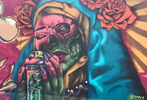
Rappers and Street Art: A Vibrant Intersection of Urban Expression
, by Bobby Banks, 5 min reading time

, by Bobby Banks, 5 min reading time
The worlds of hip-hop and street art have always been closely intertwined, both serving as creative outlets for people to express their thoughts, emotions, and experiences in urban environments. While some may view the two art forms as separate entities, there is no denying that rappers and street artists often share a common bond in their quest to bring awareness to social and political issues. This article explores the dynamic relationship between rappers and street art, examining the impact of their collaborations on the cultural landscape.
The birth of hip-hop in the late 1970s and early 1980s coincided with the rise of street art, particularly in New York City. As hip-hop culture evolved to include rapping, breakdancing, DJing, and graffiti, it became evident that these art forms shared a symbiotic relationship. Graffiti, in particular, was seen as the visual component of hip-hop, with artists such as Jean-Michel Basquiat, Keith Haring, and Dondi White pioneering this movement. Rappers and street artists often share similar backgrounds and experiences, providing an authentic and unfiltered lens into the lives of people in urban communities. The street art movement has allowed rappers to visually convey the messages in their lyrics, while also giving street artists an opportunity to collaborate with prominent musicians and elevate their own work.
There are numerous instances of rappers and street artists collaborating to create a unique fusion of visual and auditory expression. Some notable examples include:
Jay-Z and Shepard Fairey: In 2013, Jay-Z teamed up with street artist Shepard Fairey to create the cover art for his album "Magna Carta Holy Grail." The collaboration showcased Fairey's signature style, combining bold graphics and typography with images of Jay-Z.
Kendrick Lamar and Eddie Peake: For his 2017 album "DAMN.," Kendrick Lamar collaborated with British street artist Eddie Peake to create the album cover. The striking red cover features a photograph of Lamar in front of a brick wall, with the word "DAMN." painted in large white letters.
Nas and Jorit Agoch: In 2018, Italian street artist Jorit Agoch painted a massive mural of rapper Nas in Queensbridge, New York City, to pay homage to the artist and his influence on the hip-hop community.
These collaborations between rappers and street artists not only create powerful visual statements but also contribute to the ongoing dialogue surrounding social and political issues. By working together, these artists can amplify their voices and reach a broader audience, drawing attention to critical topics and inspiring change. For example, in 2020, street artist Banksy created a powerful piece in response to the death of George Floyd, which resonated with the public and became a symbol of the Black Lives Matter movement. Rapper and activist Killer Mike has also used his platform to speak out against social injustice, often incorporating the visual language of street art in his music and activism. The relationship between rappers and street artists is a testament to the power of collaboration and the impact that art can have on society. By combining their talents, these artists create thought-provoking works that challenge the status quo and push the boundaries of what art can be. As we continue to see the lines between hip-hop and street art blur, it is clear that this dynamic relationship will continue to evolve and inspire future generations of artists and activists.
Rappers and street art have long been associated with one another as key components of urban culture. Both forms of expression have evolved from the streets, drawing inspiration from the realities and challenges faced by those living in urban environments. The vibrant intersection of these two art forms has allowed for a unique exchange of ideas and creativity, leading to a dynamic, ever-evolving cultural landscape.
Shared Origins: Hip-hop culture, which includes rapping, has its roots in the South Bronx of New York City in the 1970s. Similarly, street art, characterized by graffiti, murals, and stencil art, also emerged around the same time in the same neighborhoods. The two art forms have since grown together, becoming intrinsically linked to the identity of urban communities worldwide.
Social and Political Commentary: Both rappers and street artists often use their mediums to address social and political issues relevant to their communities. They provide a platform to amplify marginalized voices, critique power structures, and advocate for change. This shared mission has led to collaborations between rappers and street artists, with many artists creating iconic album covers or live performance backdrops for hip-hop artists.
Style and Aesthetics: The visual elements of street art often complement and inspire the lyrics and beats of rap music. Bold colors, striking images, and intricate patterns are commonly found in both art forms. Additionally, the use of typography and calligraphy in graffiti art has similarities with the wordplay and rhythm of rap lyrics.
Cultural Impact and Influence: The popularity of rap music and street art has spread beyond their original urban environments and into mainstream culture. Both forms of expression have influenced fashion, film, advertising, and even academic discourse. Their unique styles and messages continue to shape the way people understand and interpret the urban experience.
Mutual Support and Collaboration: Many rappers and street artists have formed strong connections and collaborations, recognizing the potential for synergy between their respective crafts. This has led to an exchange of ideas, with artists incorporating elements of each other's work into their own. Some well-known collaborations include Banksy's work with Run The Jewels and Shepard Fairey's iconic Obama "Hope" poster.
The vibrant intersection of rappers and street art represents a powerful convergence of urban expression. The shared origins, social and political commentary, aesthetic styles, cultural impact, and mutual support between these two art forms have fostered an enduring creative partnership that continues to evolve and inspire new generations of artists and audiences.
 en
en